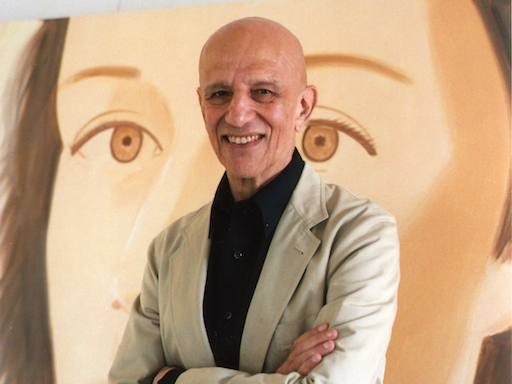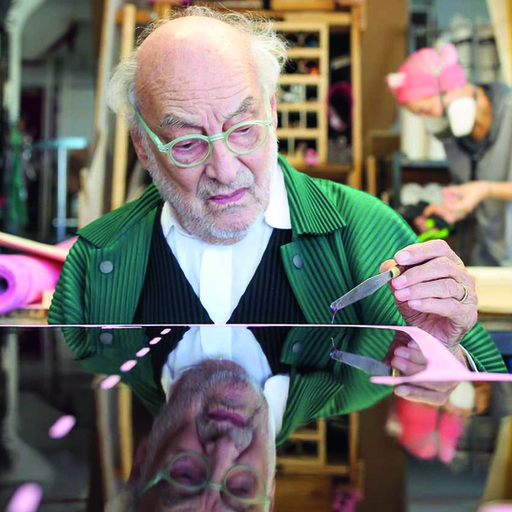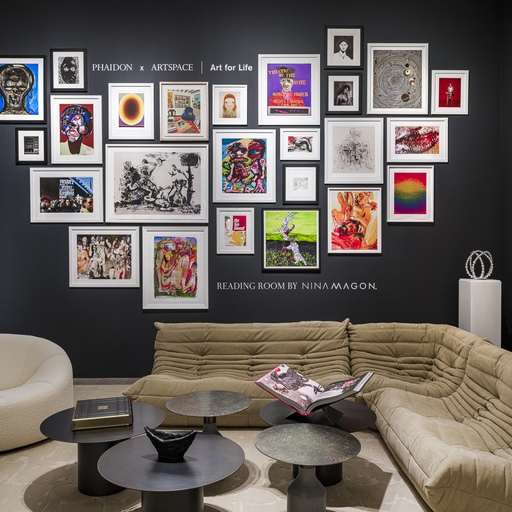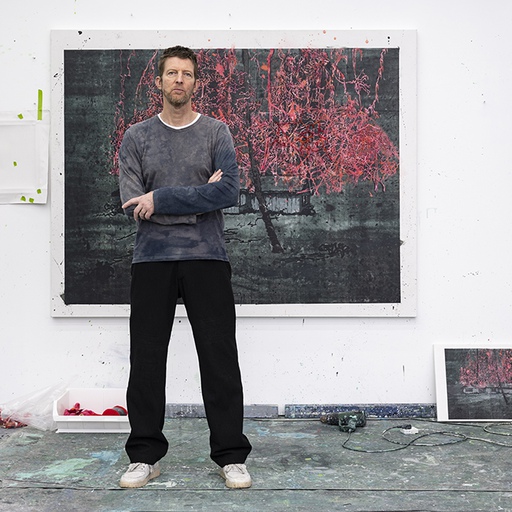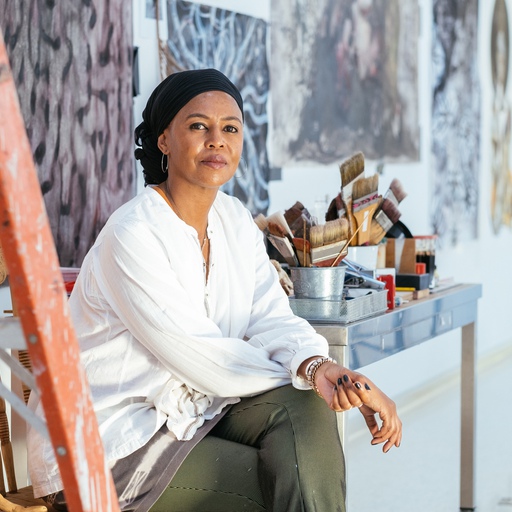When one thinks of the work of Alex Katz, one often thinks of flatness. That's actually somewhat misleading. Katz's famous paintings—alive with color and expressive line and often portraying people who are beautiful but psychologically mum, almost Etruscan in their inscrutability—have tremendously dynamic surfaces, the product of his demanding method of painting wet paint into wet, allowing the colors to mingle. For over half a century, however, the artist has been creating masterful prints that boil down his paintings to their essential qualities, presenting them as more or less pure images. These prints—which Katz has made through such various processes as lithography, etching, screenprinting, intaglio, woodcuts, aquatint, and vernis mou—are now the subject of a sweeping retrospective at the Museum of Fine Arts, Boston.
To learn more about Katz's printmaking, represented on Artspace by this fine (and funny) sculptural aluminum print of a cow, Artspace editor-in-chief Andrew M. Goldstein spoke to the artist about his work, his influences, and what he is working on now. (Hint: gigantic paintings.)
Printmaking has been an important part of your artistic practice since the beginning of your career, and some of your most celebrated images—such as The Swimmer, from 1974—are prints. What first attracted you to printmaking?
I don't know, it was just something that people do so I thought that I would try it. My first prints, I guess, were at Blackburn, which was a place on 14th Street that had drawing classes and a print shop. I tried an etching there, and then I did some woodcuts in the '50s, and then I did some stencils in the middle '50s. Those were the beginnings. In the '60s a lot of people were getting involved with prints, and I tried it again and I liked doing it so I just continued it. And it was a nice social activity in the sense that prints are more affordable and they made the art more accessible to people.
How do your prints relate to your paintings?
Well, the very early ones weren't directly related to them. But when I started in the '60s what I felt was that it was very hard to get to a good image. And certain images, after I made the paintings, seemed like they would be interesting to make as a print. The first one I made was Luna Park [1965], and it was like taking a thousand tones and reducing it to five or six. It was interesting, and it worked out really well. And it was fun to experiment with lithographs, and with painting under and over. The technical stuff was very interesting to me.
You once called your prints "surrogate images." What do you mean by that?
Basically what that means is making images that can stay on the wall rather than in a little box under a bed. I mean, people usually kept prints in boxes or put them in hallways, and I was interested in making a print that could really take the place of a painting. That would have wall power.
Your interest in printmaking arose in part as a reaction to the growing use of photography in the art—making process, with many painters today working from photos a conceptual gesture. What link do you draw between photography and printmaking?
I like photography—not to make, but I like looking at photos, that's about it. I only took photos, I guess, in the '90s over a couple of summers, but basically I don't like taking photos. In the end, the general thing is that printmaking is more primitive, and it's more physical, and it has more punch. You have less refinement in the kind of prints I do than something that is photo-based.
You've said before that you're interested in capturing a moment of "frozen time" in your art. Could you explain what that means?
It's when you get in the immediate present and you gain total consciousness. That's what it's about. Total consciousness—you're just totally awake, everything's open. You go through most of your life semi-conscious, really. Every so often something wakes you up. You get it in music a lot—in great music you get total consciousness, you're just really alive. What I'm trying to do is capture that idea.
Tell me about the way one of your works evolves from a painting to a print.
The paintings start out with direct sketches, and then they get enlarged—you try to take the direct sensation that you had in the sketch and make it large-scale. Then, for the print, you have the image already and you're pretty much working from that image or an idea to get the effect that you initially got almost unconsciously.
How long does this trajectory from the direct sketch to the painting to the print take?
I don't know, it can be years. Sometimes it's months, sometimes it's years. Sometimes a print takes a year or so to make.
You're celebrated for your portraits, which you famously make of your wife, Ada, but also of poets, artists, and assorted people in your extended circle. How do you choose the people you portray?
I don't know, it's instinctive. You have an idea and the person sort of fits it. The person fits what you're doing.
Is there a type of look that has resonated with you over time? It's been pointed out that there aren't many, let's say, hefty Alex Katz portrait subjects.
Hefty? No, not too many. I guess there's a whole part of America I'm missing [laughs]. I'm not trying to paint everyone, just people who fit what I'm trying to do.
Your portrait of a cow is one of your more beloved prints. What can you tell me about that cow? It's a Maine cow, I believe?
Yeah, it's a Maine cow, but it comes from Italy. There was an experimental farm up there that had these cows and they're very exotic in the United States, and they were sort of in a very attractive place where you could go and see them. I've painted cows before, going way back into the '60s—they always seemed like fun. So I painted this cow in a small painting, a small cutout, and then I made a cow that was almost life-size-four feet across, or something like that—and it was just a big fun image.
The cow is a reminder of how important Maine, where you have long had a house, has been for your art as a setting to the nature paintings that are a crucial analogue to your more urban portraits. What does making art from nature, in these bucolic settings, mean to you?
It's really a state of consciousness, where I can paint automatically. When I started out I did a lot of paintings from photographs, but when I figured out how to paint pretty much from my unconscious then I could apply it to different things, and I started with the landscape.
This print is on aluminum, which hearkens back to some of the earliest works that got you attention: the cutouts you made of Washington crossing the Delaware for a play by Kenneth Koch in 1961.
Oh, that was fun. They were on plywood. Now they're in the Smithsonian Museum, they have just about all of them. Martha Jackson bought most of them, and they were given to the museum.
What do you like about the cutout format?
Well, I just stumbled into it, and it seemed very exciting because of the whole thing with perception, making things seem life-size. Also, it made me wonder why conventional sculptures end where they do. Sculpture usually ends at the neck or the waist—it never ends in the middle of the head or something, so I fooled around with that a little. When I painted the cutouts it sort of destroyed the materiality of what it was on because it was like an illusion, and I liked that. It was an interesting idea to me.
Do you think about these works as prints or sculpture?
The cutouts are sculpture as far as I'm concerned. They're real sculptural objects, and they're radical in the sense that they are dematerializing. It's the opposite of a big piece of bronze or something that is manufactured.
Picasso also made flat sculptures, which yours remind me of.
Yeah, Picasso is a real influence. He really flattened it out. He's a fantastic sculptor, and I'm sure I'm influenced by when he did those flat cutout things. His things are more like drawings almost—he didn't go into illusionistic light.
In your dedication in the show's catalogue, you thank 17 different people and studios that you made prints with over the course of your career. How do you like such a collaborative form of making art as opposed to the more solitary work of painting in your studio?
I like it. It's interesting. I did a lot of stage sets and dance costumes, and when you work with a printer or a dancer or something like that there's an element of chance in there. You don't know where something's going, you know? And you get some energy from a good printmaker or a good stage designer, and that energy is interesting.
Rauschenberg made one of his more famous prints from a stone that broke in the lithography process—he called it Accident. Is this chance aspect of printmaking something that appeals to you?
Well, you never know. When you make a print you start out and then you get a proof, and you have to adjust your idea to the proof. I was in Japan once and the guy didn't get my color right, so he tried it again and he got this great blue that wasn't accurate to the painting. So what I did was adjust all my colors to that blue. So you adjust your idea to the proof, and what you get is not something you ever expected.
You worked with Picasso's longtime printmaker Aldo Crommelynck before he passed away. What is it that makes a true master printmaker?
I've worked with seven or eight guys who are really tops, really good. Crommelynck worked with Picasso, and Picasso liked to work on the plates a lot and do spit bites. Now, spit bites can be in irregular tones, and Picasso seemed to like that. I didn't like it much at all. But what Crommelynck had were these fantastic aquatints—his aquatints were amazing. And so I worked toward what he could do well. I worked a little bit with him in color and it didn't work out at all, so most of the work that I did with him was in black and white. And we experimented with etching and did things that no one had ever done before technically. It was sort of a lot of fun—it was real serious.
What, in your view, makes an exceptional print?
Magic. Just magic. When all of a sudden it goes beyond what you're doing, what you were thinking about, and turns into something else. It comes from the collaboration, from elements of chance—all kinds of things go into it. It's the idea you start with and how it gets adjusted. You never know how it's going to really resonate.
Matisse has been a major influence on your art, and you first encountered him at an early point in your career, when he was being shown at the Pierre Matisse Gallery. Right now you are approaching the same age that Matisse was when he did that show. How has your approach to printmaking evolved over time?
Oh, I'm more free and more direct now, and I make less mistakes. There's less going over proofing—I pretty much know that the marks I make on the plate or on a cutout or even on a wood thing are much more what I want than before. I used to have to do more adjusting. And these printers I'm working with are really good, so that eliminates a lot.
What is it in particular about Matisse's art that influenced you?
Matisse was a fantastic technical guy, he could do so many things with so little. I think he's an extraordinary artist.
Who among younger artists working today do you think are doing interesting things when it comes to printmaking?
Elizabeth Peyton does very nice etchings that I saw. I think Peter Doig is doing very nice movie posters. Luc Tuyman's work translates into printing very graciously.
Now you're at a gallery, Gavin Brown's Enterprise, that also represents Peyton and Doig. They've clearly been influenced by your work and look up to you, which must be nice.
Yeah. It feels the most relaxed I've ever been that way in a gallery. I actually did a show a while ago back when they were on Broome Street with Elizabeth and Andy Warhol, so I've known her for a long time.
Your art is often grouped with Warhol's. What do you think of Warhol's work?
The thing with Warhol is that he was basically a great graphic artist. He's not a painter. And his work has a different quality. He's such a terrific graphic artist that he could make things that are more interesting than a lot of paintings, but it's not the same thing as a painting, for me.
What are you working on these days?
I did a lot of work this winter, I did a lot of flowers, and I ended up with a lot of white roses and some paintings of the same person twice in two different sizes, and that worked out well. I don't know where to take it. And now I'm just doing my cabinetwork, small paintings of women in scarves. But the roses were really strange. I got to a 9-by-18-foot one with big roses, and I didn't know where I was. It's pretty wild, absolutely over my head. None of this work has been shown.
What is it like to paint at such large scale?
Well, I tell you, on most of those big things I don't know where I am. You say, well, can I do it? But by the time I get to painting one of them I've painted them at least four or five times in different sizes, so technically I sort of know what I'm doing, but you're never prepared for what the thing looks like. So the roses were really strange for me. And then I did another large one with a brown background with autumn flowers that is going to be shown at the Tate St. Ives. They took it out of the studio the other day. And I really didn't know if that painting was any good, it just looked really strange and people seemed to like it a lot, and so I guess it is. I guess it did do what I wanted it to do.
Painting at large scale was your great innovation back in the Abstract Expressionist days, when you made big, aggressive paintings of faces that could hold their own against the heroic, theatrically brushy abstract paintings of the day.
Oh, absolutely. Listen, the large painting wasn't something they did much in Europe at that time. They were painting more for living rooms. And no one was taking the figurative painting into large scale, so it seemed like an interesting thing to go into. It was a reaction to that heavy Abstract Expressionist rhetoric. But painting a large picture was something that a lot of people used to be into. The first time I got to the Louvre I was 35 and I saw those Veroneses and I said, "Whew." They were really an inspiration.
Who are some of the other artists who influenced your move toward larger paintings?
Well, Pollock sort of opened up the big painting and made it really spread. That was kind of the first guy. And I liked the way that Bonnard opened it up, so it was no longer enclosed. Most of the paintings in Europe were enclosed in black lines or enclosed in forms—a lot of them were indoors and within closed forms. When you think of a Leger, Beckmann, Picasso, Matisse, Mondrian, they were all using a black line. And Pollock sort of opened it up with another frame of reference. After Pollock and Bonnard, I looked at Tintoretto, who is open. And then the same thing with Veronese, who is very open. And I like the color weights with Rothko, which seemed to come out of Matisse. And the scale of Newman, and de Kooning's eclecticism. Kline was my favorite of them all, because it related to now and it also related to traditional painting.
I've read that you use a projector to create some of your larger paintings, which was something Kline was known for, using a projector to enlarge his drawings onto his canvases.
Yeah, he started by taking his sketches up with a projector and painting on them, and that started his career off, actually. But when he was painting on the projection, he moved around a lot—he moved around more, you know? When I use a projector it's just to establish the linear content. I'm working a different way.
Your early career is often cast as being in conflict with the Abstract Expressionists, with you trying to find another path forward.
I was in conflict, but they are like the grammar of what I paint. They were the people I was looking at. You know, the flat color and the idea of color as weight comes from looking at Rothko and Kline. There's a weight to the color, and it opens up—it's flat but it opens up. That comes from looking at Abstract Painting. That's the grammar of my painting, and that's why my paintings look slightly strange when you put them next to old—fashioned realistic work, or more traditional realistic work.
De Kooning said that Pollock broke the ice.
Well, it did for me. It was a way out of the school of Paris.
Who do you see your work as influencing these days?
Well, it seems that my work is accessible to a lot of people—it's not hermetic. So I think every ten years there's another bunch of people using it. But if you go back, Andy Warhol took a lot. The flat background, the figures, the double portraits—that all comes from me. I did the flat backgrounds and the figures in the late '50s, that was the most sensational style and everyone was looking at them, and so was he. I mean, the double portraits? Come on. Ada Ada was 1959; he did Double Elvis in 1963.
Now you said you're working on a new series of double portraits.
Yeah, with different scale changes. I did four of them and they came out real well, and I'm working on the fifth one and I don't know where to go with it. And I just have to wait and it'll come to me.
In Depth
Alex Katz on "Distilling Art to Its Essence"
